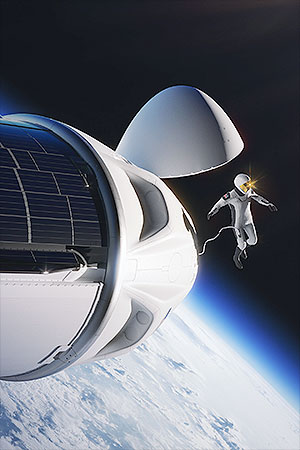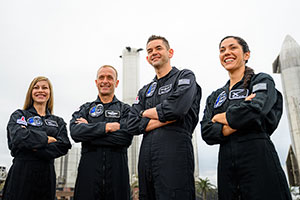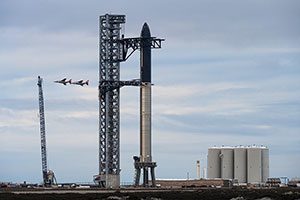February 14, 2022 — The billionaire commander of the first "all-civilian" space mission has now filed a new flight plan, underwriting a series of three SpaceX launches designed to rapidly advance human spaceflight capabilities while also raising funds and awareness for causes here on Earth.
Jared Isaacman, the 39-year-old founder of Shift4, an online payment processing company, and the commander of last year's Inspiration4 mission, revealed his "Polaris Program" on Monday (Feb. 14), a trio of commercial spaceflights to begin on SpaceX's existing Dragon spacecraft as soon as November or December of this year and culminate in the first crewed launch of SpaceX's new Starship in the years to come.
"The Polaris Program is the next chapter in our journey to make humanity become a truly spacefaring civilization," Isaacman said in a call with reporters on Monday.
The program's first launch, titled "Polaris Dawn," will launch Isaacman as the mission's commander, together with three crewmates, including: pilot Scott "Kidd" Poteet, a retired lieutenant colonel in the U.S. Air Force who served as the mission director for Inspiration4; mission specialist Sarah Gillis, who oversees SpaceX's astronaut training program; and medical officer Anna Menon, who manages the development of SpaceX's crew operations and serves in the company's mission control. (Menon is married to Anil Menon, a member of NASA's latest astronaut candidate class, meaning she will now be flying into space before her husband.)
Polaris Dawn
The Polaris Dawn crew will expand upon the achievements of the record-setting Inspiration4 mission. In September 2021, Isaacman and his three Inspiration4 crewmates (Sian Proctor, Hayley Arceneaux and Chris Sembroski) spent three days aboard a Dragon spacecraft in Earth orbit, reaching a maximum altitude of 364 miles (565 km) — the fifth-highest orbital human spaceflight in history.
"On Polaris Dawn, we endeavor to achieve the highest Earth orbit ever flown," Isaacman said.
That record is currently set at 853 miles (1,373 km), as achieved by NASA's Gemini 11 astronauts, Charles "Pete" Conrad and Richard "Dick" Gordon, in 1966. Apollo crew members, including Conrad and Gordon, later flew farther from Earth on missions to the moon, but the Gemini 11 record continues to stand today as the highest Earth orbit reached by astronauts.
"Ultimately, it will really come down to vehicle performance and what we're able to accomplish while ensuring that we have a path to come home safely," said Gillis.
At its peak altitudes, the Polaris Dawn mission will pass through portions of the Van Allen radiation belt — the donut-shaped swaths of magnetically-trapped, highly-energetic charged particles that surround Earth — providing the crew the opportunity to collect data on the effects of space radiation exposure on human health as among the mission's science research objectives.
Lower in their orbit, at approximately 300 miles (500 km) above Earth, at least two of the Polaris Dawn crew members will attempt the first commercial extravehicular activity (EVA), or spacewalk. SpaceX's Dragon does not include an airlock, so the entire cabin will be depressurized before the hatch is opened. For the EVA, the crew will wear new SpaceX-designed spacesuits, upgraded from the company's existing pressure suits.
"The development of these suits and the execution of the EVA will be important steps toward the scalable design for spacesuits for future long duration missions," Isaacman said.
Guiding light
The new spacesuits, along with a planned first test of SpaceX's Starlink satellite network for laser-based communications in space, are intended to advance the technologies needed for future missions to the moon, Mars and into deep space. Like its namesake Polaris, which is a constellation of three stars more commonly known as the "North Star," the Polaris Program seeks to be a guiding light, helping humanity navigate its way to new destinations.
The second Polaris mission will follow based on what the crew and SpaceX learn during the first mission.
"We're going to learn as much as we can from the Polaris Program side of things, SpaceX is going to learn an awful lot as they're getting Starship ready for its first human spaceflight and I think we're going to combine that to ultimately form what the second mission should look like," Isaacman said.
The third launch will be the first human spaceflight of SpaceX's Starship, a heavy-lift rocket and spacecraft that is being developed as the world's first fully-reusable transportation system designed to carry both crew and cargo into Earth orbit, to the moon, Mars and elsewhere further out into the solar system. The date for that mission is unknown, but will come after the vehicle has been tested on numerous uncrewed flights.
Like the Inspiration4 mission, which through contests, auctions, sales and donations raised a total of $240 million for St. Jude Children's Research Hospital, the Polaris Program also seeks to benefit the hospital's programs to improve the global survival rates for childhood cancer.
"I'm incredibly passionate that we can make meaningful progress towards a world we all want to live in for tomorrow, while also working to address the challenges and hardships of today. It does not have to be one or the other, but in fact can be both," said Isaacman. |
|

The first commercial spacewalk is planned for the first mission of billionaire Jared Isaacman's newly-announced "Polaris Program," dubbed "Polaris Dawn," to be launched with a crew of four as soon as November or December 2022. (Polaris Program)

Polaris Dawn crew members Anna Menon, Scott "Kidd" Poteet, Jared Isaacman and Sarah Gillis. (Polaris Program/John Kraus)

The Polaris Dawn mission patch depicts a spacewalking astronaut outside of SpaceX's Dragon spacecraft as reflected in the spacesuit visor of another crew member. (Polaris Program/John Kraus)

Members of the Polaris Dawn mission, including Jared Isaacman and Scott "Kidd" Poteet, fly by a prototype SpaceX Starship on the launch pad in Boca Chica, Texas. (Polaris Program/John Kraus) |
